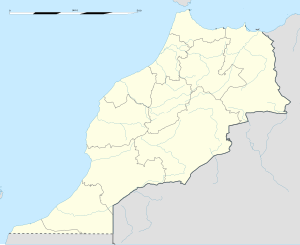Battle of Tétouan
| Battle of Tetuán | |||||||
|---|---|---|---|---|---|---|---|
| Part of the Marià Fortuny. | |||||||
| |||||||
| Belligerents | |||||||
|
|
| ||||||
| Commanders and leaders | |||||||
|
|
| ||||||
| Strength | |||||||
|
25,000 men 65 pieces of artillery 41 ships | 35,000 | ||||||
Location within Morocco | |||||||
The Battle of Tetuán (
Arabic: معركة تطوان, Spanish: Batalla de Tetuán) was fought on 4 to 6 February 1860, near Tetuán, Morocco, between a Spanish army sent to North Africa and the tribal levies which at the time made up the Moroccan Army. The battle was part of the Spanish-Moroccan War of 1859–1860
.
Background
The Spanish expeditionary force, which departed from
The 1st Conde de Reus. Admiral Segundo Díaz Herrero commanded the fleet. The objective of the Spanish forces was to take Tetuán, which had served as a base for raids on Ceuta and Melilla
.
Hostilities between Moroccan and Spanish troops began on 17 December 1859 when the column commanded by
Christmas Day
, the three columns had consolidated their positions and awaited orders to advance towards Tetuán.
Battle
On 1 January 1860, the
Conde de Lucena began a march towards the objective of Tetuán, and was supported by forces composed of Catalan volunteers. Covering fire was provided by units commanded by General The Conde de Reus and General Ros de Olano
. Spanish artillery inflicted heavy losses on the Moroccan ranks; the Moroccan forces that remained took refuge in Tetuán. The city fell on 6 February 1860. A week of further fighting followed before hostilities ceased.
Aftermath
The capture of
President of the Council of Ministers
(also known as the Prime Minister).
Cultural references

Salvador Dalí painted a version of Fortuny’s painting of the battle.[1][2]
The Spanish victory was carved and painted on the pediment of the Church of San Joaquín, Iloilo, considered a militarist-themed church in the Philippines. It was declared a national historical site in 1974. It was built in 1859 and completed in 1869 by the Spanish friar Tomas Santaren of the Augustinian Order.[3]
Gallery
-
The Battle of Tetuán, by Dionisio Fierros (1894, private collection).
-
General Prim in the War of Africa" (in Catalan: El General Prim a la guerra d'Àfrica), by Francisco Sans Cabot (1865, formerly at the Barcelona Military Museum, now closed)[4]
References
- ^ La batalla de Tetuán Archived February 5, 2008, at the Wayback Machine
- ^ Las Batalla de Tetuán Archived January 14, 2008, at the Wayback Machine
- ^ http://www.exploreiloilo.com/do/info/san-joaquin-church/Explore[permanent dead link] Iloílo, San Joaquin Church Iloilo, San Joaquin Church
- ^ Francesc Sans i Cabot in the Gran Enciclopèdia Catalana. Retrieved on 25 July 2013
External links
Wikimedia Commons has media related to Battle of Tetuan.



